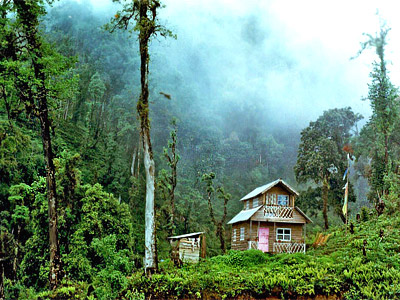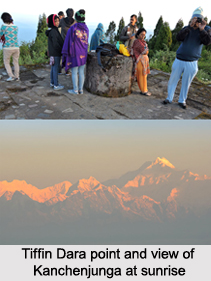 Rishop, also known as Rishyap, is a Himalayan hamlet in West Bengal, with rural settlement of the Lepcha community. Situated at an altitude of 2591 metres above sea-level, this aesthetically appealing village offers a picturesque view of the snow-capped Kanchenjunga, the third highest mountain peak in the world.
Rishop, also known as Rishyap, is a Himalayan hamlet in West Bengal, with rural settlement of the Lepcha community. Situated at an altitude of 2591 metres above sea-level, this aesthetically appealing village offers a picturesque view of the snow-capped Kanchenjunga, the third highest mountain peak in the world.
Location and Environment in Rishop
According to locals, the term Rishop is derived from the words "Ri", meaning mountain peak and "shop", which means old trees. Rishop forms an integral part of the famous Neora Valley at the foothills of the Tiffin Dara, which is an uninterrupted 360-degree viewpoint of the majestic Kanchenjunga.
It is distanced at 11 kilometres from Lava, another tourist spot, by road or merely 4 kilometres of trekking trail. It is rated as the most popular site in the Kalimpong District of West Bengal, distanced around 35 kilometres from there.
The environment in this peaceful place is nothing but an absolute example of the nature"s scenic beauty. Away from the hustle-bustle of the city life, the village is nature at its pure best, with man-made service such as electricity and other aspects of evolution and development, non-existent here. The local Lepchas and Sherpas there have built small cottage type accommodations for the tourists, thus painting an absolute quaint and medieval impression to this attractive spot.
Natural Tourism Attractions in Rishop
The natural beauty of the Neora Valley National Park and the Tiffin Dara are major tourist attractions in Rishop.
The small place with its natural beauty is experienced entirely by strolling around. There are no means of transport. Suited best for a one-day stint, Rishop is explored by trekking along through the dense and quiet forest of pine, birch, fir and different varieties of orchids, accompanied with the melodious chirpings of birds and company of some mountainous dogs also showing the way. This adventurous trek is what leads to the two major natural attractions.
Tiffin Dara is like a flat rocky platform created as a viewpoint. "Dara" means hilltop in the Lepcha language. Giving a 360-degree uninterrupted and scintillating panorama of the Kanchenjunga mountain range, this point is reached after about 1.5 kilometres of uphill trek. It also meant to watch sunrises and sunsets. During the sunsets, the gold-capped peaks of the mountains with a play of rainbow colours are seen.
The scenic beauty has the sun playing vermillion throughout the day and after nightfall, the big sky seems to have come closer and beneath it is the twinkling lights of adjoining city Gangtok and small town Pedong that appears strikingly similar to the stars twinkling up in the sky. It can only be imagined how much this enhances the already mesmerizing visual appeal.
 In addition to the many peaks of the magnificent and humongous Himalayas, some parts of the Jalep La and Nathu La Pass, Tin Simana and Tibet hills can also be sighted from Rishop.
In addition to the many peaks of the magnificent and humongous Himalayas, some parts of the Jalep La and Nathu La Pass, Tin Simana and Tibet hills can also be sighted from Rishop.
Accommodations at Rishop
Being promoted as a tourist destination, Rishop in the resent past has had a number of private accommodations and lodges set up for the tourists. Almost all are village home stay type, with basic facilities of running water, attached bath and descent food.
Visiting Information for Rishop
There are 3 options for tourists to visit Rishop:
By Road: The nearest jeep and bus stands are at Lava, 4 kilometres downhill from Rishop. To reach Lava, it takes about two hours and a half from Siliguri, the nearest major city. From Lava, it is best to trek up to Rishop. The Lava Monastery is at southeast of Rishop. The 11 kilometres boulder and bumpy road from Lava to Rishop gives glimpses of step-farming in the cultivation of maize, potato and cabbage.
By Rail: New Jalpaiguri is the nearest major railhead, from where Rishop is about 110 kilometres via Kalimpong district, taking about 4 hours to reach. New Mal Junction is the nearest railway station from Lava, about 70 kilometres from Rishop.
By Air: Bagdogra is the nearest airport, from where Rishop is about 130 kilometres, taking four hours and a half to reach.
Best Season for visiting Rishop
The best season to visit Rishop is during summer between April and July, as the weather is moderate with mild temperature not rising above twenty degrees. The rhododendrons and orchids are in full bloom and the clear sky provides a marvellous view of mountain peaks.
The village can also be toured during autumn in October and November when the view of mountain peaks is magnificent but the flowers will not be seen.
Rishop should not be visited during the rainy season, as chances of landslides and getting stranded remains during the time.
An eco-tourism committee was set up here so that the village could be properly developed. Rishop, thereafter, is growing steadily in terms of number of tourists and nature lovers, who take an adventurous break to peacefully connect with Mother Nature, and savour her aesthetic and panoramic impressions abundantly evident here.



















